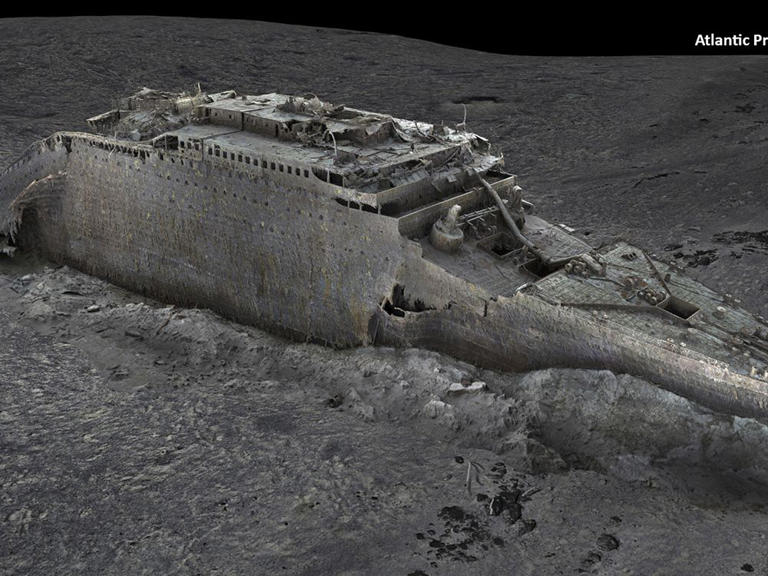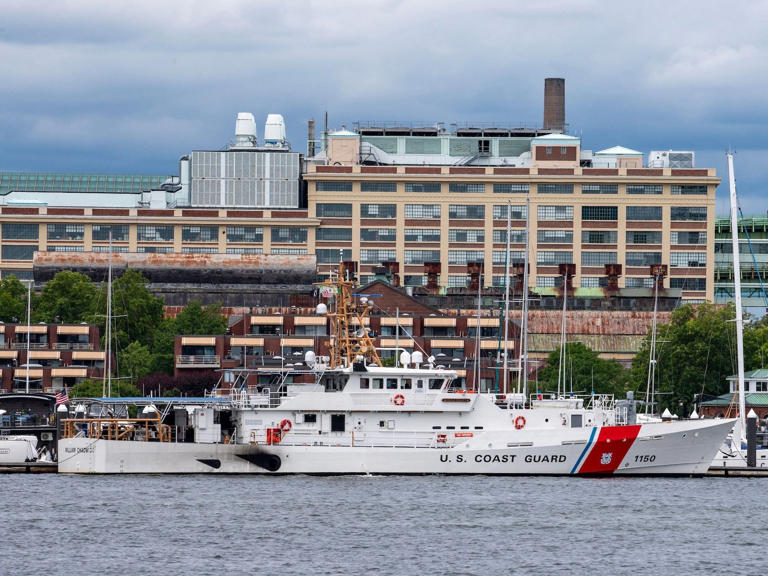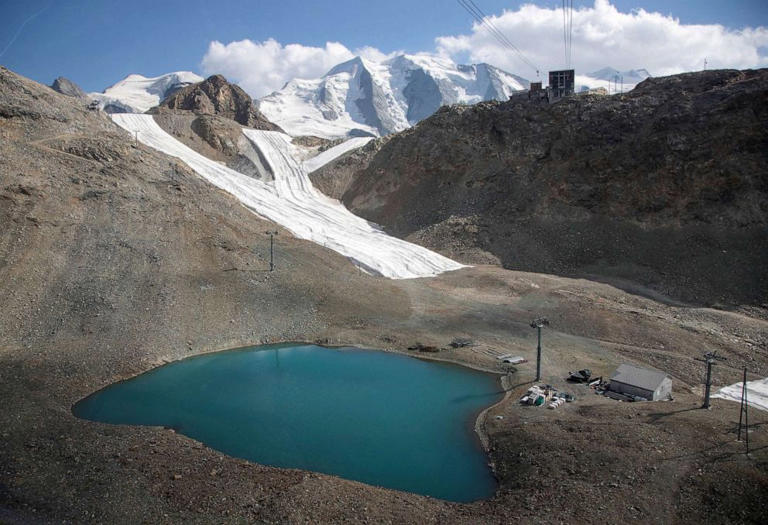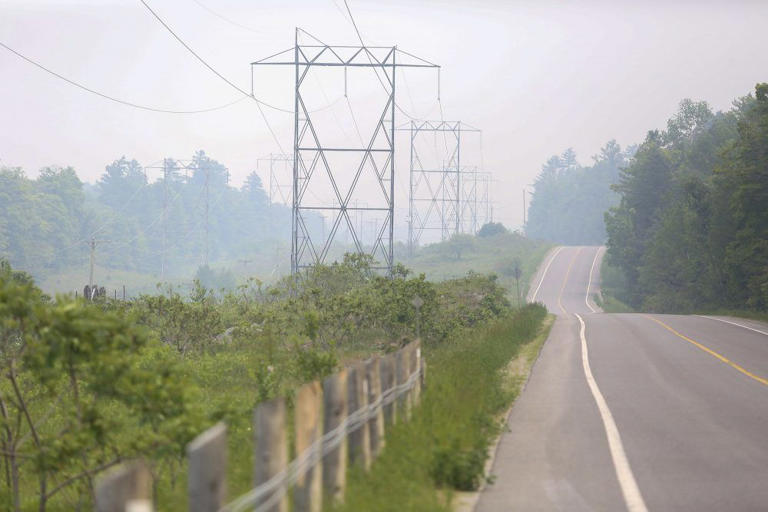The (incredibly expensive) Titanic tourism industry that just lost a submarine
Story by Tristin Hopper • Yesterday

A view of the bow of the Titanic from a digital scan released by Atlantic/Magellan in May 2023. The ship — which sank on its maiden voyage in April, 1912 — lies under nearly four kilometres of Atlantic Ocean, making it an extremely exclusive tourist destination.
Only a few days after setting out from St. John’s, N.L., a tourist expedition to the wreck of the RMS Titanic has gone missing .
Both the U.S. Coast Guard and Canada’s Joint Rescue Coordination Centre in Halifax confirmed that a deep-sea submersible was reported overdue on Sunday night. An RCAF Aurora patrol aircraft and the Canadian Coast Guard vessel Kopit Hopson were soon underway to assist in search and rescue operations.
There was no sign of the submersible as of press time, but the incident may already have done inalterable damage to what has previously been one of the world’s most exclusive tourist experiences.
Climbing Mount Everest costs about $50,000 . A ticket to space could soon cost only $100,000 . But descending to the RMS Titanic currently costs US$250,000 ($330,000) per person.
The missing submersible is owned by OceanGate Expeditions, a U.S.-based company whose vessel, the Polar Prince, is partially owned by the Newfoundland and Labrador-based Miawpukek First Nation. “This is your chance to step outside of everyday life and discover something truly extraordinary,” reads a description for the company’s June 2023 Titanic expedition.
On Monday, it emerged that one of the missing submersible’s passengers is U.K. billionaire Hamish Harding.
Although media reports said the search was being conducted “off the coast of Canada,” that’s only technically true: The search area is a remote patch of the North Atlantic more than 600 kilometres from Newfoundland.
The RMS Titanic is not only the world’s most famous shipwreck, but it’s one of the hardest to reach.
The vessel — which sank on its maiden voyage in April, 1912 — lies under nearly four kilometres of Atlantic Ocean. That’s 12 times deeper than history’s deepest scuba dive , and four times deeper than the lowest depth ever reached by a conventional U.S. Navy submarine. Merely descending to the wreck takes about two hours.
That’s one of the reasons the wreck wasn’t discovered until 1985.
It wasn’t until after the Second World War that marine technologists — most notably the French oceanographer Jacques Cousteau — were able to pioneer the development of submersibles that could reach the bottom of the mid-Atlantic without getting crushed.
To this day, there’s still only a handful of vehicles that can safely carry humans to the wreck, almost all of which are in the hands of militaries and research institutions.
The wreck was first explored in the 1980s with ALVIN, a research submersible owned by the Woods Hole Oceanographic Institution. And when Canadian filmmaker James Cameron dove to the site to shoot footage for his 1997 blockbuster Titanic, he hired Mir 1 and Mir 2; deep-sea submersibles operated by the Russian Academy of Sciences.
Ever since the 1990s, there has been a steady trickle of sightseeing expeditions to the Titanic wreck. The two Mir submersibles were contracted for a tourist expedition in 1998 , and in 2001 an American couple even arranged to be married in a submersible perched on the bow of the sunken vessel; they’d won the dive in a competition offered by the British company SubSea Explorer.
These have not been uncontroversial. The sinking claimed the lives of more than 1,500 people, only a few hundred of which had their bodies recovered, meaning that the wreck is officially a mass grave. RMS Titanic Inc. — the U.S. company that owns salvage rights to the wreck — has also sought court injunctions against earlier sightseeing visits.
When OceanGate Expeditions began operations in 2018, they boasted of having the world’s only privately-owned vehicles capable of reaching the Titanic.
The missing craft is the Titan submersible, which has room for four passengers and one crew member. Specs released by OceanGate note that it is lighter than most of its deep-sea submersible peers by virtue of being partially constructed from carbon fiber rather than the traditional titanium.
“In coastal waters this means we do not need a large support ship with a crane or A-frame,” they write.
Story by sgrindell@insider.com (Samantha Grindell) • Yesterday

A vessel that takes passengers to see the Titanic wreckage is missing. Drew Angerer/Getty Images© Drew Angerer/Getty Images
A vessel that takes tourists to see the Titanic shipwreck is missing with five passengers on board.
The vessel is considered a submersible, not a submarine, because it needs a ship to help it launch.
The missing submersible is equipped with oxygen for five people for 96 hours.
Search-and-rescue efforts are underway to find a missing vessel that takes tourists to see the Titanic shipwreck.
The vessel is called Titan and is owned by OceanGate Expeditions, which takes passengers to see the Titanic wreckage.
Titan can carry five people to a depth of 13,123 feet, according to the OceanGate website.
Notably, Titan is a submersible, not a submarine. As the National Oceanic and Atmospheric Administration website explains, a submarine can launch itself into the ocean from a port independently, while a submersible does not have the power to get to port, the bottom of the ocean, and back.
Instead, submersibles are launched from support ships, which take the submersible to the site where the vessel will deep dive, similarly to how a boat deposits a scuba diver into an area of the ocean to explore.

The Titan. OceanGate© Provided by INSIDER
Titan's location is unknown because it lost contact with its support ship, Polar Prince, as CNN reported.
As OceanGate told the BBC, Titan's dive began on Sunday after Polar Prince escorted the submersible to the site of the Titanic wreckage, which is near Newfoundland, Canada. The submersible lost contact with Polar Prince less than two hours into its journey.
Five passengers were on board Titan for its dive, and the vessel is equipped with life support for those passengers for 96 hours from the time of departure, according to OceanGate's website.
The US Coast Guard is carrying out search-and-rescue operations to attempt to find the submersible, with Rear Admiral John Mauger of the US Coast Guard saying the "remote" location of the site is making the efforts more difficult.

The US Coast Guard is searching for the missing Titan.
Ocean Gate released a media brief on Monday saying that it was "exploring and mobilizing all options to bring the crew back safely" and that the company's "entire focus is on the crewmembers in the submersible and their families."
As Insider previously reported, tickets to board an OceanGate expedition to the Titanic wreckage cost $250,000 each.
Jun 20, 2023
The missing Titanic tourist submersible was piloted with a Logitech gamepad controller.
A CBS News segment from November showed details of the vessel, which contains "off-the-shelf" parts.
Per the report, several dives were canceled due to weather, and one group got lost for several hours.
The tourist submersible that went missing while carrying five people to the sunken Titanic on Sunday was designed to be piloted with a video game controller and fitted with "off-the-shelf" components.
Details of the vessel, called the Titan, were reported in a November CBS TV segment that featured the submersible, its mother ship, and crew.
The Titan's main compartment has as much space as a minivan, according to CBS correspondent David Pogue. Footage of the vessel shows that its interior can accommodate around five people sitting cross-legged, as well as several screen displays and some camera equipment.
"We only have one button, that's it. It should be like an elevator, it shouldn't take a lot of skill," said Stockton Rush, the CEO of OceanGate Expeditions, in CBS News' video. OceanGate conducts deep-sea tours on in the Titan submersible.
Some of the parts inside the submersible are "off-the-shelf components," Rush told Pogue, saying that one of its interior lights was bought from recreational vehicle company CamperWorld.
"We run the whole thing with this game controller," Rush said, showing Pogue a modified Logitech gamepad controller.
CBS also shot footage of a small space inside the Titan where one can relieve themselves in a bottle.
But Rush disagreed when Pogue said the Titan, which is supposed to carry passengers to depths of 13,000 feet, seemed to have a "MacGyver jerry-riggedness."
The CEO and his team worked with Boeing, NASA, and the University of Washington to create the vessel to withstand deep sea pressure.
"Everything else can fail," Rush said. "Your thrusters can go, your lights can go, you're still going to be safe."
OceanGate's website said the Titan combines "ground-breaking engineering and off-the-shelf technology," and that the latter "helped to streamline the construction" and makes the submersible easier and simpler to operate.
The Titan, being a submersible and not a submarine, does not have enough power to leave port and return on its own, and instead relies on a mother ship to carry and retrieve it.
While the Titan is diving, it receives navigational instructions via text messages from a ship, which has crew members monitoring the submersible's location, Pogue reported.
Pogue sailed for several days with OceanGate's crew while waiting for a successful dive to the Titanic wreck. Several dives were canceled due to poor weather, and at least one was aborted because several floats became detached from the Titan, per CBS.
On the same tour, a group diving in the Titan also got lost for two and a half hours and couldn't find the shipwreck, according to one of its passengers.
The submersible went missing on Sunday after losing contact with its mother ship less than two hours after submerging, per the US Coast Guard.
US and Canadian authorities have launched a search and rescue operation, deploying at least two aircraft, a submarine, and sonic buoys to scan the area. But officials say the search area is both vast and remote, posing challenges to the rescue effort.
On Monday, the Coast Guard said the Titan is likely to have between 70 to 96 hours of oxygen left, given that the vessel usually makes dives with around four days of emergency life support.
OceanGate typically operates eight-day tours to see the Titanic, and charges around $250,000 per client. Multiple dives are conducted throughout the voyage.
OceanGate did not immediately respond to a request for comment sent by Insider outside regular business hours.
A search was underway Monday in an area of the Atlantic Ocean about 700 kilometres south of Newfoundland for a small submersible reported missing during a dive to view the wreckage of the Titanic. Here are a few facts about the missing vessel and its owner, Washington-based OceanGate Expeditions.
1. The Titan is a 6.4-metre manned submersible made of carbon fibre and titanium, designed to carry five people to depths of up to 4,000 metres for "site survey and inspection, research and data collection, film and media production, and deepsea testing of hardware and software," according to OceanGate's website. The craft includes a large viewport to allow passengers to view their surroundings, and is lowered into the water with the help of what the company calls a "patented, integrated launch and recovery platform."
2. The vessel carried a combination of crew and tourists, who pay huge fees to view the wreck site and participate in research tasks. The Canadian Press reported that in 2019, the price was about $168,000 per ticket — an amount said to subsidize the company's Titanic research mission.
3. The company says its mission includes chronicling the deterioration of the wreck of the Titanic, which sank in 1912, leading to the deaths of more than 1,500 people. The expeditions capture photos and video to document the condition of the site, as well as the plants and animals in and around it. "What we’re doing is something that’s going to add to the historical record of the Titanic — what is it like now, how is it decaying, what kind of marine life is there," CEO Stockton Rush told The Canadian Press in 2019.
4. A promotional video on the company's YouTube channel says the passengers depart from St. John's, N.L., aboard a surface vessel for an eight-day journey. The trips down to the Titanic wreck are monitored by specialists in a command centre aboard the ship, on which guests are treated to lectures and conversations with scientists, and help out with various tasks related to research.
5. The company says the submersible includes a real-time health monitoring system, which makes it possible to analyze the effects of changing pressure on the submersible as it dives. The submersible is said to have a life-support system lasting 96 hours.
6. Rush founded OceanGate in 2009. It carried out successful Titanic expeditions in 2021 and 2022, the website says.
This report by The Canadian Press was first published June 19, 2023.
The Canadian Press

Rescuers in a remote area of the Atlantic Ocean raced against time early Tuesday to find a missing submersible carrying five people on a mission to document the wreckage of the Titanic, the iconic ocean liner that sank more than a century ago.
The submersible named the Titan, part of a mission by OceanGate Expeditions, carried a pilot, a renowned British adventurer, two members of an iconic Pakistani business family and another passenger. Authorities reported the vessel overdue Sunday night about 435 miles (700 kilometers) south of St. John’s, Newfoundland, according to Canada's Joint Rescue Coordination Center.
Every passing minute, however, puts the Titan's crew at greater risk. The submersible had a 96-hour oxygen supply when it put to sea at roughly 6 a.m. Sunday, according to David Concannon, an adviser to OceanGate.
“It is a remote area — and it is a challenge to conduct a search in that remote area,” said Rear Adm. John Mauger, a commander for the U.S. Coast Guard, which also is searching for the Titan. “But we are deploying all available assets to make sure we can locate the craft and rescue the people on board.”
The Canadian research icebreaker Polar Prince, which was supporting the Titan, reportedly lost contact with the vessel about an hour and 45 minutes after it submerged. The Polar Prince will continue to do surface searches throughout the night and Canadian Boeing P-8 Poseidon reconnaissance aircraft will resume their surface and subsurface search in the morning, the U.S. Coast Guard said on Twitter. Two U.S. Lockheed C-130 Hercules aircraft also have conducted overflights.
In an email to The Associated Press, Concannon said he was supposed to be on the dive but could not go. He said officials were working to get a remotely operated vehicle that can reach a depth of 3.7 miles (6 kilometers) to the site as soon as possible.
OceanGate’s expeditions to the Titanic wreck site include archaeologists and marine biologists. The company also brings people who pay to come along, known as “mission specialists.” They take turns operating sonar equipment and performing other tasks in the five-person submersible.
The Coast Guard said Monday that there was one pilot and four “mission specialists” aboard. However, OceanGate's website suggests that the fifth person aboard may be a so-called “content expert” who guides the paying customers.
OceanGate said its focus was on those aboard and their families.
“We are deeply thankful for the extensive assistance we have received from several government agencies and deep sea companies in our efforts to reestablish contact with the submersible,” it said in a statement.
British businessman Hamish Harding, who lives in Dubai in the United Arab Emirates, was one of the mission specialists, according to Action Aviation, a company for which Harding serves as chairman. The company’s managing director, Mark Butler, told the AP that the crew set out on Friday.
“There is still plenty of time to facilitate a rescue mission, there is equipment on board for survival in this event,” Butler said. “We’re all hoping and praying he comes back safe and sound.”
Harding is a billionaire adventurer who holds three Guinness World Records, including the longest duration at full ocean depth by a crewed vessel. In March 2021, he and ocean explorer Victor Vescovo dived to the lowest depth of the Mariana Trench. In June 2022, he went into space on Blue Origin’s New Shepard rocket.
Harding was “looking forward to conducting research” at the Titanic site, said Richard Garriott de Cayeux, the president of The Explorers Club, a group to which Harding belonged.
"We all join in the fervent hope that the submersible is located as quickly as possible," he said in a statement.
Also on board were Pakistani nationals Shahzada Dawood and his son Suleman, according to a family statement sent to the AP. The Dawoods belong to one of Pakistan's most prominent families. Their eponymous firm invests across the country in agriculture, industries and the health sector.
“We are very grateful for the concern being shown by our colleagues and friends and would like to request everyone to pray for their safety while granting the family privacy at this time,” the statement said. “The family is well looked after and are praying to Allah for the safe return of their family members.”
Shahzada Dawood also is on the board of trustees for the California-based SETI Institute that searches for extraterrestrial intelligence.
The expedition was OceanGate’s third annual voyage to chronicle the deterioration of Titanic, which struck an iceberg and sank in 1912, killing all but about 700 of the roughly 2,200 passengers and crew. Since the wreckage’s discovery in 1985, it has been slowly succumbing to metal-eating bacteria. Some have predicted the ship could vanish in a matter of decades as holes yawn in the hull and sections disintegrate.
The initial group of tourists in 2021 paid $100,000 to $150,000 apiece to go on the trip. OceanGate’s website had described the “mission support fee” for the 2023 expedition as $250,000 a person.
Unlike submarines that leave and return to port under their own power, submersibles require a ship to launch and recover them. OceanGate hired the Polar Prince to ferry dozens of people and the submersible craft to the North Atlantic wreck site. The submersible would make multiple dives in one expedition.
The expedition was scheduled to depart from St. John’s, Newfoundland, in early May and finish up at the end of June, according to documents filed by the company in April with a U.S. District Court in Virginia that oversees Titanic matters.
CBS journalist David Pogue, who went on the trip last year, noted his vessel got turned around looking for the Titanic.
“There’s no GPS underwater, so the surface ship is supposed to guide the sub to the shipwreck by sending text messages,” Pogue said in a segment aired on CBS Sunday Morning. “But on this dive, communications somehow broke down. The sub never found the wreck.”
The submersible, named Titan, is capable of diving 2.4 miles (4 kilometers) “with a comfortable safety margin,” OceanGate said in its court filing.
It weighs 20,000 pounds (9,072 kilograms) in the air, but is ballasted to be neutrally buoyant once it reaches the seafloor, the company said.
In a May 2021 court filing, OceanGate said the Titan had an “unparalleled safety feature” that assesses the integrity of the hull throughout every dive.
During its expedition in 2022, OceanGate reported that the submersible had a battery issue on its first dive, and had to be manually attached to its lifting platform, according to a November court filing. More missions, however, followed. The company reported that 28 people visited the wreck site last year.
Experts said Monday that rescuers face steep challenges.
Alistair Greig, a professor of marine engineering at University College London, said submersibles typically have a drop weight, which is “a mass they can release in the case of an emergency to bring them up to the surface using buoyancy.”
“If there was a power failure and/or communication failure, this might have happened, and the submersible would then be bobbing about on the surface waiting to be found,” Greig said.
Another scenario is a leak in the pressure hull, in which case the prognosis is not good, he said.
“If it has gone down to the seabed and can’t get back up under its own power, options are very limited," Greig said. “While the submersible might still be intact, if it is beyond the continental shelf, there are very few vessels that can get that deep, and certainly not divers.”
Even if they could go that deep, he doubts they could attach to the hatch of OceanGate's submersible.
Jun 20, 2023
Ben Finley And Holly Ramer, The Associated Press
Jun 20, 2023
Businessman Hamish Harding was aboard the Titanic tourist submersible that went missing on Sunday.
Harding wrote on Instagram that there was bad weather but a "window" had opened up for a dive.
Harding has been on several adventures, including a trip on Blue Origin's spaceflight in June 2022.
British billionaire Hamish Harding was aboard the Titanic tourist submersible when it went missing on Sunday.
Harding's stepson, Brian Szasz, confirmed his disappearance via posts on his Facebook and Twitter accounts.
"Hamish my stepdad is lost in a submarine thoughts and prayers that the rescue mission will be successful," Szasz said in his Facebook post on Monday.
Harding, the founder and chairman of an aircraft brokerage company Action Aviation, is a prominent adventurer and thrill seeker.
The businessman made an Instagram post on Saturday, the day before the five-person crew made their fateful dive.
"Due to the worst winter in Newfoundland in 40 years, this mission is likely to be the first and only manned mission to the Titanic in 2023. A weather window has just opened up and we are going to attempt a dive tomorrow," Harding wrote on Instagram.
Harding holds three Guinness World Records, including one for spending the "longest time traversing the deepest part of the ocean on a single dive."
The 58-year-old was one of the passengers on Jeff Bezos' rocket company Blue Origin's fifth human spaceflight in June 2022.
Mark Butler, Action Aviation's managing director, told the AP that he thinks there is "still plenty of time to facilitate a rescue mission" and that the submersible has "equipment on board for survival in this event."
"We're all hoping and praying he comes back safe and sound," he added.
Five passengers, including Harding, are aboard the submersible. Search efforts by the US Coast Guard are currently ongoing.
But time is running short, and the crew in the submersible could run out of oxygen by Thursday afternoon — that is, if the vessel is still intact.
Representatives for Harding at Action Aviation did not immediately respond to a request for comment from Insider sent outside regular business hours.















